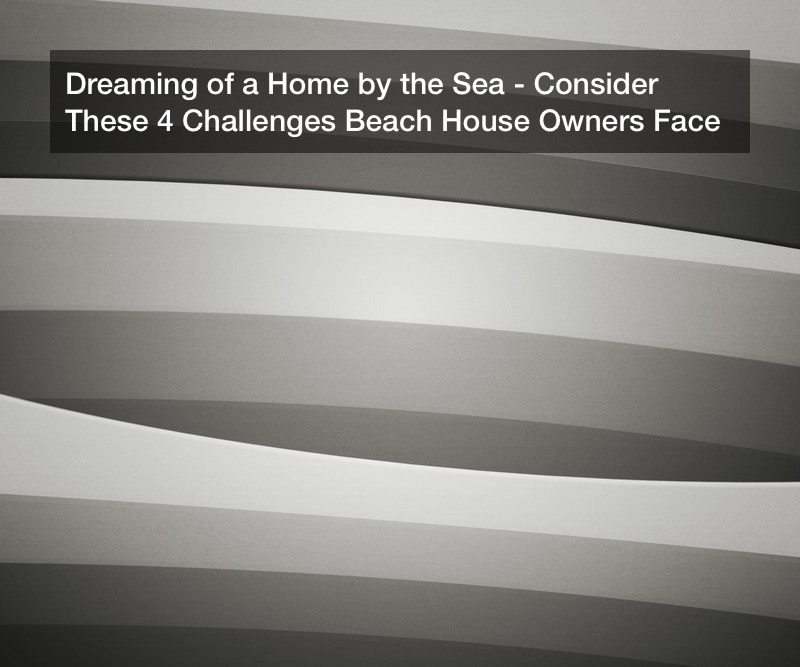Our website may receive compensation from partner links and videos placed in our content.
We are not experts in any particular field. Our content is written by those interested in the various topics, not by professionals. All content is intended to be informational and should not take the place of professional advice. Before making any decisions that could be life altering, please consult with a professional in the field.
All homes require regular maintenance and upkeep, from plumbing service to electrical work to roof and siding repair. But beach houses need a little extra TLC due to the wear and tear the natural environment poses on the structure and surrounding landscape. If you’re considering becoming the proud new owner of seaside real estate, make sure you do your due diligence and know exactly what you’re signing up for. There are many reasons to buy a beach house: from the luxurious vacation experience to the stunning ocean views, purchasing a home by the sea is regarded as the ultimate aspiration for so many property owners. A seaside property offers easy access to some of your favorite hobbies and pastimes as well as unrivaled natural beauty. It also, however, comes with a few unique challenges. Here are four factors to keep in mind when considering the pros and cons of owning a beach house.
Mold and Mildew
While the proximity to the ocean is certainly considered a benefit by those looking to buy a seaside property, buildings near the water are subject to the pervasive nature of moisture and humidity. Your air conditioning system might keep you comfortable indoors on a hot, humid day, but you can’t dismiss the impact humidity can have on both the structural integrity of the building and the indoor air quality.
Unfortunately, mold and mildew are common in beach houses and other seaside properties. When humidity affects a porous surface, it cultivates the ideal conditions for mold growth. Ignored or unattended, mold and mildew can affect your health, causing respiratory problems and allergic reactions.
You can take certain precautions to reduce the likelihood of mold growth. One easy way to prevent mold is to avoid leaving wet towels, swimsuits, and clothing lying around. Wash and dry sea-soaked garments immediately upon returning home or leave them outside on a clothesline to dry before bringing them inside. Also, measure your indoor humidity to try to keep it below 60%; installing a dehumidifier can help regulate the moisture in your home. Water damage can also lead to mold and mildew; just like you would with any home, make sure your gutters are clear (it’s important to clean them at least twice a year) and directing water away from the home’s foundation.
Wear and Tear from Sun, Surf, and Sand
If your waterfront property is in a location that sees a lot of direct sunlight, you’ll notice that your exterior finishes will age prematurely. Harsh UV rays degrade many types of materials: untreated wood falls apart or is blackened or bleached, plastic becomes brittle and colors fade, and the heat can cause asphalt shingles to buckle. Doors and siding may start bubbling or blistering as the paint becomes so hot that it practically boils. When these blisters pop, the material underneath is exposed to the elements, which could cause further damage if not replaced. With the help of a professional landscaping service, you can mitigate some of this risk by planting trees and shrubs that block out the sun. Still, you’ll need to be diligent about maintaining your home’s exterior.
Salty air and sand blowing inland from the beach can rust metalwork and chip and scratch paint. Unfortunately, the damage caused by salt and sand is unavoidable. Unless you were to erect a wall around your property, obstructing your lovely view of the sea, the elements are guaranteed to affect your home’s exterior. Specialized coatings and protective sealants are available to prevent or slow the oxidization of metals. Some experts also recommend applying a coat of car wax to metal surfaces every couple of months. When possible, use rust-resistant metals like cast aluminum.
Hurricane Damage
Each year, roughly 12 named storms hit the U.S., with two to three reaching category three to five. Hurricanes and severe tropical storms pose a major threat to both your home and your own safety, particularly if your home is on the Atlantic coast, which is the most vulnerable to these storms. Because there are no barriers between your beach house and an oncoming hurricane, your property is particularly vulnerable to high wind and heavy rain, leading to possible water damage, toppling structures, and flying debris. As such, having strong protection in place is essential for keeping you and your house safe.
Hurricane proof windows, storm shutters, and impact doors are a must-have. Hurricane resistant windows are designed with shatter-proof glass. This laminated glass technology contains two separate pieces of glass and a layer of resin between those two panes to create a much more stable structure than traditional glass windows. Of course, a hurricane proof window could still crack under extreme pressure, but there won’t be any shattered glass shards to cause further damage or bodily harm. Additionally, the combination of a hurricane proof window’s strong metal frame and weather stripping provides a stable foundation for the glass.
You can also take proactive measures to limit the amount of damage caused by a tropical storm or hurricane, like removing weak tree branches or branches that hang over the house, securing loose fencing, and anchoring heavy objects like patio furniture into the ground. Even category one hurricane winds have been known to reach speeds of 95 miles per hour, so check for signs you need a new roof or even minor roof repair before and after a storm.
Sure, if you’ve got a modular home, you could pick up and move to a safer location — moving modular homes from one place to another is pretty standard. But doesn’t that defeat the purpose of purchasing a seaside home?
Vandalism and Burglary
Is the beach house of your dreams located in a prime vacation spot? If so, you might encounter a lot of tourist traffic. In populated areas like this, vandalism and burglary are not uncommon occurrences. And your home might be considered a good target if you aren’t there to keep an eye on it year-round. It’s essential to install a high-quality security system. Fortunately, we’re living in a high-tech age; today’s security systems often include 24/7 monitoring that will even send real-time video to your computer or mobile device. You can also receive notifications when something seems suspicious.
Did you know that almost 40% of burglaries are not forced entries? Intruders often enter a home through a door or window with no trouble at all. That means you need to make sure your doors and windows are locked and reinforced, and you should never leave a spare key “hidden” under a potted plant or the doormat. Instead, if you fear accidentally locking yourself out, get to know your neighbors and leave a spare key with them. In fact, close-knit neighborhoods typically experience fewer break-ins because strangers are easier to spot. Especially if you don’t live in your beach house full-time, find a trusted neighbor and ask them to watch out for any odd activity around your home.
If owning a beach house and living by the sea is a dream of yours, don’t let the challenges listed above stop you from finding your perfect seaside oasis. Sure, there’s certain to be more upkeep and maintenance involved than simply keeping an eye on your plumbing and regularly changing your smoke alarm batteries. Storms, sun, surf, sand, and suspicious strangers all pose threats to your home’s safety and security, but if you are prepared for the extra responsibility, go for it! And if your waterfront home has an HOA or property management company, always be sure to alert them to any issues you encounter, big or small.





